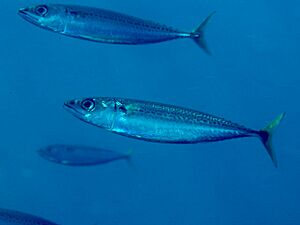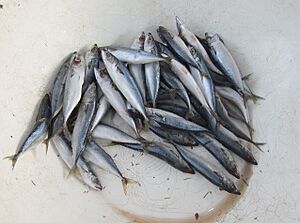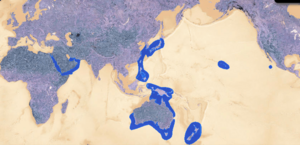Blue mackerel facts for kids
Quick facts for kids Blue mackerel |
|
|---|---|
 |
|
| Conservation status | |
| Scientific classification | |
| Synonyms | |
|
The blue mackerel (Scomber australasicus) is a cool fish that belongs to the Scombridae family, which also includes tuna. You might also hear it called the Japanese mackerel, Pacific mackerel, slimy mackerel, or spotted chub mackerel. These fish usually grow to about 30 cm (12 in) long and can weigh up to 1.4 kg (3.1 lbs).
Contents
What Does a Blue Mackerel Look Like?
Blue mackerel are often confused with their close relatives, the chub mackerel. For a long time, people even thought they were the same! But scientists found that blue mackerel have different genes. There are also some easier ways to tell them apart. Blue mackerel have a longer spine near their bottom fin and a different number of spines on their first back fin. Both types of mackerel have a round body that gets narrower towards their tail, a bit like a tuna fish.
Where Do Blue Mackerel Live?
You can find blue mackerel in the warm, tropical, and subtropical parts of the Pacific Ocean. They live from Japan all the way south to Australia and New Zealand. They also swim in the eastern Pacific, near Hawaii and Socorro Island, Mexico. In the Indo-West Pacific, they are found in places like the Red Sea, the Persian Gulf, and the Gulf of Oman. These fish usually stay in surface waters, but they can go as deep as 200 meters (660 ft).
Blue mackerel prefer water temperatures around 10°C (50°F). Off the east coast of North America, their numbers have grown a lot since 1982, with over 2 million fish now swimming there. You can find blue mackerel along the coasts of North America, and as far away as Australia and Japan.
How Do Blue Mackerel Live?
Blue mackerel are known for being very hungry eaters! They will eat almost anything they can find. This includes tiny plankton, small shrimp-like creatures called krill, little fish like anchovies, and even dead bait. They will also bite at fishing lures and flies. When a group of blue mackerel is in a feeding frenzy, they might even try to eat things that aren't food, like cigarette butts or bare hooks! They mostly eat smaller fish that live in the open ocean. Because they eat so much and are active during the day, blue mackerel have developed large eyes with very sensitive retinas to help them see food.
How Long Do Blue Mackerel Live?
Blue mackerel eggs hatch in about 3 to 8 days. The warmer the water, the faster they hatch. In the East China Sea, blue mackerel lay their eggs between February and May when the water is just right. Near New South Wales, Australia, most spawning happens about 10 km (6 mi) offshore in waters 100 to 125 meters (330 to 410 ft) deep. Ocean currents can carry the eggs and young fish away from where they were laid, helping blue mackerel spread out. However, the further they travel, the less likely they are to survive. A blue mackerel is considered an adult when it's over 31 cm (12 in) long. These fish can live up to 7 years and grow to 50 cm (20 in), but most are found to be between 1 and 3 years old. Scientists can figure out a mackerel's age by counting the growth rings on its ear bones, called otoliths.
Blue Mackerel and People

Blue mackerel can be a bit tricky to catch, especially in bays and harbors. People catch blue mackerel for both commercial fishing (to sell) and for fun. They are used as food for humans and also as bait for catching bigger fish like tuna.
Blue mackerel are often used in cat food. But people also enjoy eating them smoked, grilled, or broiled. They are easy to cut into fillets and remove the skin, but it can be hard to take out all the tiny bones without damaging their soft meat. Blue mackerel are also used in a cool way as "meat binders." After being freeze-dried, a protein from the fish is taken out and added to other meat products. This helps keep the meat and seasonings stuck together, which can make the product cheaper to make and even improve its taste and texture!
Local Names for Blue Mackerel
In Japanese, the blue mackerel is known as goma saba (胡麻鯖), which means "sesame mackerel."



